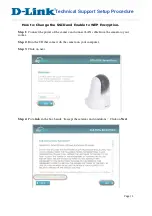
Product Manual — Doc. 9321A
IV-CAMFL-N-W-1B • 29
The image sensor in this camera offers integrated 2-step noise reduction that helps combat
noise than can appear when the camera has to compensate for dim lighting.
2DNR is the first level of noise reduction. When on, up to five levels can be set. High levels of
2DNR should only be used in low-color settings.
3DNR offers dynamic noise reduction ideal for conferencing, streaming, and more. When on, up
to five levels can be set. Setting the level too high might lead to “ghosting” when the camera is
picking up fast movement or is being moved.
MIRROR/FLIP
Used to mirror or flip the image output.
Exposure
EXPOSURE toggles between 3 predefined modes to quickly adjust exposure levels.
ANTI FLICKER: Fluorescent light sources and computer displays can induce image flickering
when outputting at frame rates of 25 or 30 fps. If you are outputting at either of these frame
rates, set the ANTI FLICKER setting to twice that value (for example, 60 Hz for a 30 fps video
signal).
COLORTONE
WHITE BALANCE adjusts the color levels of the camera image to reproduce what the human eye
sees in any given lighting.
AUTO is recommended if the lighting conditions in your venue are influenced by weather changes
or if you frequently use projections or colored lighting. Other settings are detailed in the
OSD Menu Tree table above.
To perform a one-time white balance configuration:
1. Hold a pure white piece of paper in front or the camera lens at a distance where it is
properly lit.
2. Select ONE PUSH, and press OK.
3. Continue holding the piece of paper for 10 seconds until the process is complete.
WB-SENSITIVITY adjusts the camera's color sensitivity.
Reserved Presets
To ensure backwards compatibility with various different control systems, some proprietary
camera functions are mapped to fixed preset numbers and can be triggered by calling the
associated preset.
These presets cannot be overwritten.
Preset Number
Function
80
Start tracking
81
Stop tracking
95
Open OSD Menu















































